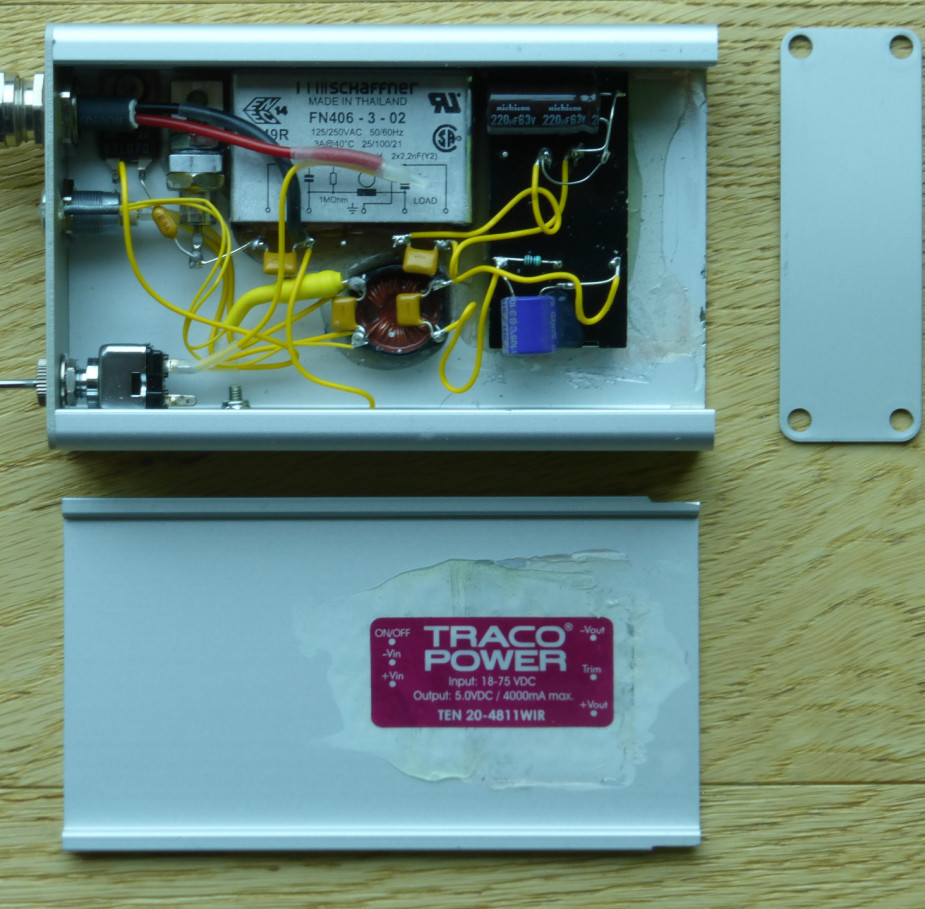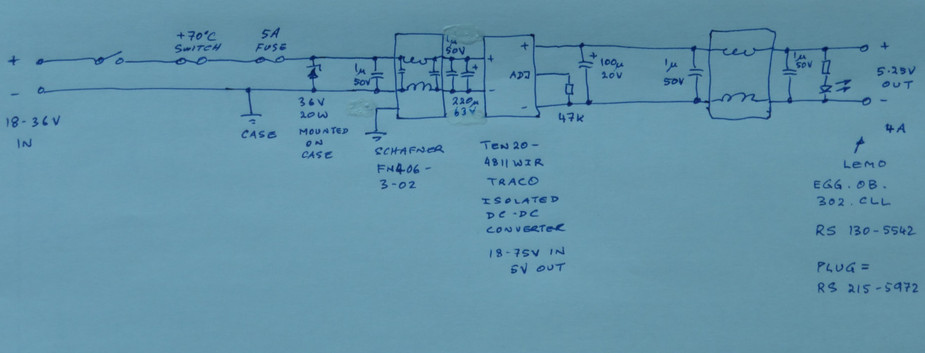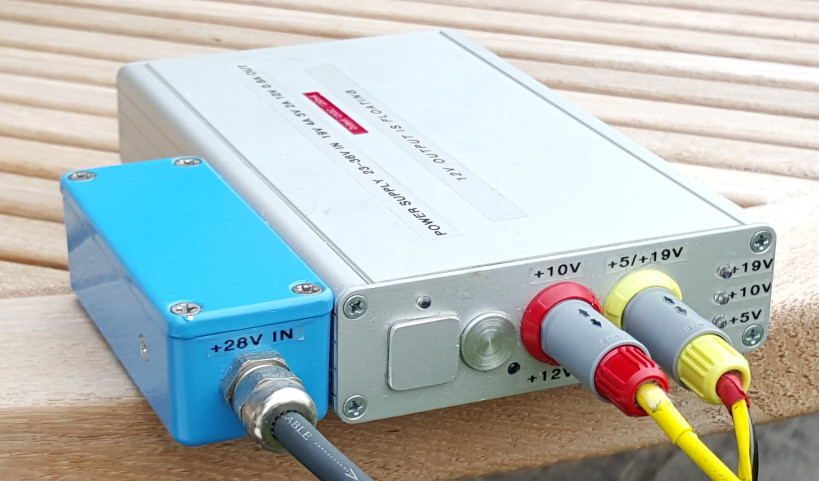In case anybody is interested in this sort of thing, I’ve just built this


It outputs 5.25V, up to 4A, and is intended to power just about anything “5V” including the products that cheat by not charging properly from 5.00V (Lenovo tablets for example).
It replaces another, multi-output, unit I built 10 years ago

which became obsolete because the 19V (old tablets) and 10V (old satphone) outputs are no longer needed.
Note the totally crazy amount of filtering on both input and output. Even with this in place, one finds that interference can be present on some VHF frequencies, hence the on/off switch.
The output (micro-USB) cable(s) will need to short together the two data wires. That is the correct way of charging non-Apple devices, which is all I use now, especially in the cockpit. Apple (IOS) devices are more complicated especially if you want to charge ar the higher currents (2A or more); they need four resistors to set up specific voltages on the two data wires.
My question here relates to this. The new 5.25V power unit has a floating output which I think is less likely to cause interference.
You should have built a 9V option too 
Your Galaxy S6 can use a 9V charge for faster charging. Though you’d need to build in some intelligence so that it steps back when it gets fuller.
Samsung (and many other manufacturers) now use this as a faster charging technology, and it’s really good.
Gosh, I never knew that… anyway, 5.25V and 4A available should be enough to keep anything (that I have) going.
The phone is actually no problem at all. That always charges OK. Plus I carry it with me so make sure it stays charged.
Out of curiosity: what is the market price of that DC/DC-converter? I have a feeling it is far too expensive for its added value (ground separation of the output circuit) which seems overkill to me because anything getting its juice from there will be separate from the chassis ground anyway.
If I were to create such a device it would use a similarly rugged case, a bit less of filtering, and a simple linear regulator. But of course I am working from a 12V system, linear from 24V= to 5V= would create quite a lot of power (19V times 4 Amp, max) converting to heat somewhere between dashboard and firewall. Another case of cost going up with at least the second power of performance…
I actually use an LT1085 to produce 12V= for my eeePC, it will get quite hot as its input gets close to 15V= when the engine runs and it can supply up to 3 amps; there’s nothing wrong with that, the chip has its thermal protection so it will reduce current as required. When the eeePC battery is totally flat it takes more than two hours to recharge, but eventually it will – no problem.
what is the market price of that DC/DC-converter?
It depends on the quality. No-name chinese, probably with fake EMC specs = say 5-10 quid for a 20W unit. Top quality US made one (possibly also chinese  ), maybe 50 quid.
), maybe 50 quid.
Also wide input range units (essential for aircraft use) cost more.
But of course I am working from a 12V system, linear from 24V= to 5V= would create quite a lot of power (19V times 4 Amp, max) converting to heat somewhere between dashboard and firewall. Another case of cost going up with at least the second power of performance…
Yes, that’s the simple way to avoid EMC issues. But 50-100W cannot be dissipated unless mounted on a big piece of aluminium. As a rough guide, a 30×30cm ally plate, 1.6mm thick, in free air, natural finish, is 1degC/watt. So a 50-100degC temp rise. That’s very hot. There aren’t many places on the airframe you could mount such a thing.
Cessna might disagree, looking at their infamous “dropper” solution for the tail strobe  But they used a very hot power resistor mounted IIRC in free air – like the old “dropper” in the back of the old valve televisions which was used to drop the difference between the incoming mains and the voltage across all the valve heaters connected in series. That sort of thing is OK if you can guarantee it won’t touch anything.
But they used a very hot power resistor mounted IIRC in free air – like the old “dropper” in the back of the old valve televisions which was used to drop the difference between the incoming mains and the voltage across all the valve heaters connected in series. That sort of thing is OK if you can guarantee it won’t touch anything.
Peter wrote:
maybe 50 quid.
Hm, in your constellation that must be quite bearable ;)
Peter wrote:
they used a very hot power resistor
Why not use two of them in parallel (or in series)? That would more than double the usesul life AND avoid a lot of nasty situations. Such ideas go against my microlighter’s mindset, of course, but it is so nice learning to think differentiated! ;)
PS I had some weird flashes across my mind about using the excess heat to de-ice the carb… but that feels wrong. Even no need to think it out.
There is no problem dissipating heat during flight. The problem is what happens when you are stationary. Something is going to get very hot…
I’ll go along with that in an alu airframe, and partially for a tube and rag. In a carbon/fibre plane, though, care is required. As I heard yesterday at a safety training: “if a carbon/fibre plane catches fire, only the engine(s) will remain – airframe and occupant(s) will be reduced to ashes.” Makes one think twice, doesn’t it?
I pre-ordered the new Nexus 5X the other day. It has the new USB-C port together with the USB 3.1 standard. This port can charge using 5-20V, 5A. I don’t know the actual specs of the charger with the phone, but the info say it can charge for “3.8 hours use in 10 minutes” (which isn’t all that fast, but faster than today’s devices, 2700 mAh battery). All new devices will have USB-C, including most laptops, also as charging port. USB-C is backward compatible, but the port itself is physically different, so adapters are required. This 5, 10, 19 V option isn’t old fashioned in any way, but should be 20V and 5A.
3.8 hours use in 10 minutes
10 mins is 6C charge rate which will hammer the battery… not something I would do given that the battery is usually not serviceable.
Old tablets/laptops often used 19V at up to 4A for charging/powering. It’s obviously easier to build a product which has a 19V or 20V input for charging – everything is more efficient at higher voltages (= lower currents = lower semiconductor losses) but I think it was the EU requirement for a common charging scheme, plus the obvious public demand for USB charging, which drove the USB (5V) charging system. On top of that, ever higher screen resolutions drove ever larger batteries which drove ever higher charging current requirements.
What the EU didn’t think of was that manufacturers will screw them by establishing incompatible means of determining how much current the device can draw from the charger  And then Lenovo broke the standard by charging only at “slightly above” 5V
And then Lenovo broke the standard by charging only at “slightly above” 5V 
I think most current tablets will charge, slowly, at 0.5A, and most of them will run with the screen on at some reasonable brightness at 1A (at 5V).